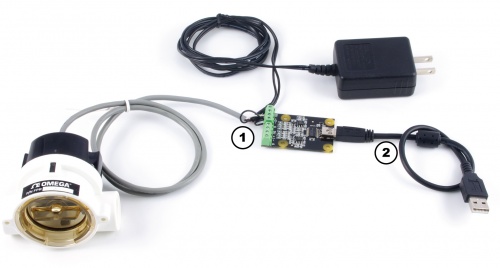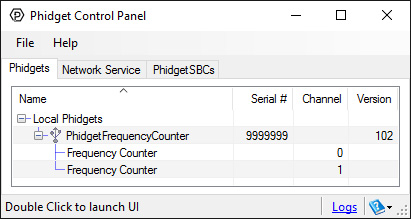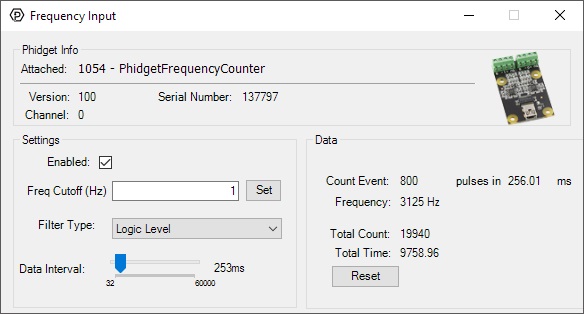1054 User Guide: Difference between revisions
No edit summary |
|||
| (14 intermediate revisions by 3 users not shown) | |||
| Line 1: | Line 1: | ||
__NOINDEX__ | |||
<metadesc>The PhidgetFrequencyCounter measures a signal's frequency and powers small devices like Hall Effect sensors, flow rate sensors, and tachometers.</metadesc> | |||
[[Category:UserGuide]] | [[Category:UserGuide]] | ||
==Getting Started== | ==Getting Started== | ||
{{UGIntro|1054}} | |||
*[{{SERVER}}/products.php?product_id=1054 1054 Frequency Counter Phidget] | |||
*USB cable and computer | |||
*something to use with the 1054 (e.g. a device with a frequency/pulse output) | |||
Next, you will need to connect the pieces: | |||
[[Image:1054_0_Connecting_The_Hardware.jpg|500px|right|link=]] | |||
# Connect your | # Connect your pulse output device to the Frequency Counter Phidget. Connect the power wire to 5V, the ground wire to G, and the positive and negative data lines to '+' and '-'. If there is only one data line, connect it to '+' if it's a PNP sensor, and '-' if it's NPN. | ||
# Connect the | # Connect the 1054 to your computer using the USB cable. | ||
= | <br clear="all"> | ||
{{UGIntroDone|1054}} | |||
{{ | ==Using the 1054== | ||
{{UGcontrolpanel|1054}} | |||
{{ugFrequencyCounter|1054}} | |||
*Modify the data interval value by dragging the slider. For more information on this setting, see the [[Data_Rate_and_Change_Trigger|data interval]] page. | |||
*Enter a filter type from the Filter Type drop-down menu. A Logic Level signal goes from alternates between 0 and VCC. A Zero Crossing signal goes from -VCC to VCC. | |||
*Toggle the Enabled checkbox to enable/disable the 1054. | |||
{{ | {{ugAddressingInformation}} | ||
{{ | {{ugUsingYourOwnProgram|1054}} | ||
==Technical Details== | ==Technical Details== | ||
===General=== | |||
The | The 1054 contains two channels to sense two different inputs. Each channel has two different circuits to sense for logic level-frequencies or zero-centered frequencies. The measurable frequency is accurate to 0.25% up to 1MHz. The 1054 may measure frequencies past 1MHz, but the input voltage specifications will not hold. The 1054 can measure frequencies down to ~0.01Hz. However the response time of these measurements is directly related to the frequency, thus it could take 1 or 2 periods(100-200s) to detect the input frequency. | ||
===Logic-Level Frequencies=== | ===Logic-Level Frequencies=== | ||
The logic-level sensing circuit has a hysteresis range from 0.9V to 2.4V. This will allow the circuit to count both 3.3V and 5V logic levels. In addition to logic-level signals, this will also accept the pulses from sensors with open collector outputs. When the input signals are either 3.3V or 5V, the maximum sensed frequency is 1.5MHz. Most digital sensors that are powered from a signal positive power supply will output a logic-level frequency. | |||
The logic-level sensing circuit has a hysteresis range from 0.9V to 2.4V. This will allow the circuit to count both 3.3V and 5V logic levels. | |||
===Zero-Centered Frequencies=== | ===Zero-Centered Frequencies=== | ||
The zero-centered sensing circuit can be used for input signals where you want to count as it crosses zero volts. A hysteresis of 30mVpp filters noise. | The zero-centered sensing circuit can be used for input signals where you want to count as it crosses zero volts. A hysteresis of 30mVpp filters noise. At maximum frequency (1MHz), a signal of 400mVPP is required for reliable counting. A common application that uses a zero centered frequency output is a simple magnetic tachometer, which produces a sine wave around 0 volts. | ||
===Differential Inputs=== | ===Differential Inputs=== | ||
The | The 1054 uses differential inputs, that is, the voltage being compared is the difference between the '''+''' and '''-''' inputs. If your application has a slightly different ground from your USB ground, the common mode rejection in the 1054 will handle small differences in ground. For many applications, the signal being measured is single ended, that is, your sensor outputs only one signal, and you can directly connect the ground of the sensor to the ground of the 1054. In this case, ensure the '''-''' input is tied to ground. Never allow either input to be left unconnected. | ||
===Output Voltage=== | ===Output Voltage=== | ||
USB Voltage is passed directly to the +5V terminal on the green blocks | USB Voltage is passed directly to the +5V terminal on the green blocks. | ||
{{UGnext|}} | |||
{{ | |||
Latest revision as of 16:13, 17 October 2019
Getting Started
Welcome to the 1054 user guide! In order to get started, make sure you have the following hardware on hand:
- 1054 Frequency Counter Phidget
- USB cable and computer
- something to use with the 1054 (e.g. a device with a frequency/pulse output)
Next, you will need to connect the pieces:

- Connect your pulse output device to the Frequency Counter Phidget. Connect the power wire to 5V, the ground wire to G, and the positive and negative data lines to '+' and '-'. If there is only one data line, connect it to '+' if it's a PNP sensor, and '-' if it's NPN.
- Connect the 1054 to your computer using the USB cable.
Now that you have everything together, let's start using the 1054!
Using the 1054
Phidget Control Panel
In order to demonstrate the functionality of the 1054, the Phidget Control Panel running on a Windows machine will be used.
The Phidget Control Panel is available for use on both macOS and Windows machines.
Windows
To open the Phidget Control Panel on Windows, find the ![]() icon in the taskbar. If it is not there, open up the start menu and search for Phidget Control Panel
icon in the taskbar. If it is not there, open up the start menu and search for Phidget Control Panel
macOS
To open the Phidget Control Panel on macOS, open Finder and navigate to the Phidget Control Panel in the Applications list. Double click on the ![]() icon to bring up the Phidget Control Panel.
icon to bring up the Phidget Control Panel.
For more information, take a look at the getting started guide for your operating system:
Linux users can follow the getting started with Linux guide and continue reading here for more information about the 1054.
First Look
After plugging the 1054 into your computer and opening the Phidget Control Panel, you will see something like this:

The Phidget Control Panel will list all connected Phidgets and associated objects, as well as the following information:
- Serial number: allows you to differentiate between similar Phidgets.
- Channel: allows you to differentiate between similar objects on a Phidget.
- Version number: corresponds to the firmware version your Phidget is running. If your Phidget is listed in red, your firmware is out of date. Update the firmware by double-clicking the entry.
The Phidget Control Panel can also be used to test your device. Double-clicking on an object will open an example.
Frequency Counter
Double-click on the Frequency Counter object in order to run the example:

General information about the selected object will be displayed at the top of the window. You can also experiment with the following functionality:
- Frequency: the average frequency calculated from the pulses in the event so far.
- Total Count: the total number of pulses since opening the example.
- Total Time: the total time in milliseconds that has elapsed since opening this example.
- Enter a cutoff frequency in the Frequency Cutoff(Hz) textbox and the 1054 will ignore frequencies below the specified value.
- Modify the data interval value by dragging the slider. For more information on this setting, see the data interval page.
- Enter a filter type from the Filter Type drop-down menu. A Logic Level signal goes from alternates between 0 and VCC. A Zero Crossing signal goes from -VCC to VCC.
- Toggle the Enabled checkbox to enable/disable the 1054.
Finding The Addressing Information
Before you can access the device in your own code, and from our examples, you'll need to take note of the addressing parameters for your Phidget. These will indicate how the Phidget is physically connected to your application. For simplicity, these parameters can be found by clicking the button at the top of the Control Panel example for that Phidget.

In the Addressing Information window, the section above the line displays information you will need to connect to your Phidget from any application. In particular, note the Channel Class field as this will be the API you will need to use with your Phidget, and the type of example you should use to get started with it. The section below the line provides information about the network the Phidget is connected on if it is attached remotely. Keep track of these parameters moving forward, as you will need them once you start running our examples or your own code.

Using Your Own Program
You are now ready to start writing your own code for the device. The best way to do that is to start from our Code Samples.
Select your programming language of choice from the drop-down list to get an example for your device. You can use the options provided to further customize the example to best suit your needs.
Once you have your example, you will need to follow the instructions on the page for your programming language to get it running. To find these instructions, select your programming language from the Programming Languages page.
Technical Details
General
The 1054 contains two channels to sense two different inputs. Each channel has two different circuits to sense for logic level-frequencies or zero-centered frequencies. The measurable frequency is accurate to 0.25% up to 1MHz. The 1054 may measure frequencies past 1MHz, but the input voltage specifications will not hold. The 1054 can measure frequencies down to ~0.01Hz. However the response time of these measurements is directly related to the frequency, thus it could take 1 or 2 periods(100-200s) to detect the input frequency.
Logic-Level Frequencies
The logic-level sensing circuit has a hysteresis range from 0.9V to 2.4V. This will allow the circuit to count both 3.3V and 5V logic levels. In addition to logic-level signals, this will also accept the pulses from sensors with open collector outputs. When the input signals are either 3.3V or 5V, the maximum sensed frequency is 1.5MHz. Most digital sensors that are powered from a signal positive power supply will output a logic-level frequency.
Zero-Centered Frequencies
The zero-centered sensing circuit can be used for input signals where you want to count as it crosses zero volts. A hysteresis of 30mVpp filters noise. At maximum frequency (1MHz), a signal of 400mVPP is required for reliable counting. A common application that uses a zero centered frequency output is a simple magnetic tachometer, which produces a sine wave around 0 volts.
Differential Inputs
The 1054 uses differential inputs, that is, the voltage being compared is the difference between the + and - inputs. If your application has a slightly different ground from your USB ground, the common mode rejection in the 1054 will handle small differences in ground. For many applications, the signal being measured is single ended, that is, your sensor outputs only one signal, and you can directly connect the ground of the sensor to the ground of the 1054. In this case, ensure the - input is tied to ground. Never allow either input to be left unconnected.
Output Voltage
USB Voltage is passed directly to the +5V terminal on the green blocks.
What to do Next
- Programming Languages - Find your preferred programming language here and learn how to write your own code with Phidgets!
- Phidget Programming Basics - Once you have set up Phidgets to work with your programming environment, we recommend you read our page on to learn the fundamentals of programming with Phidgets.

